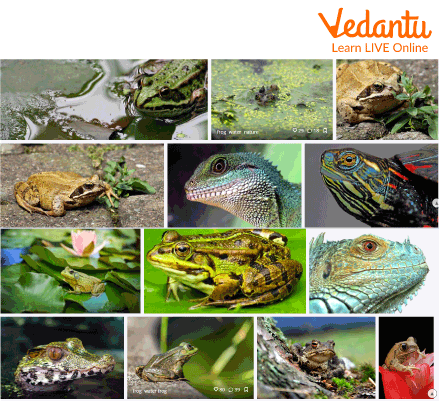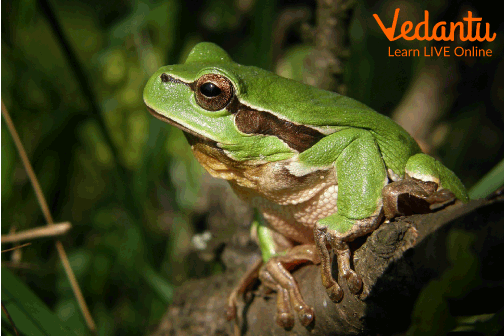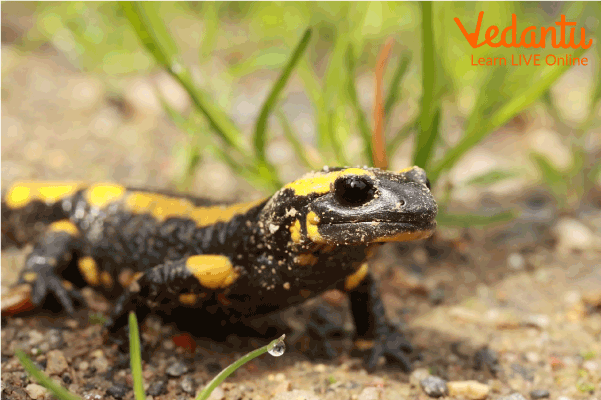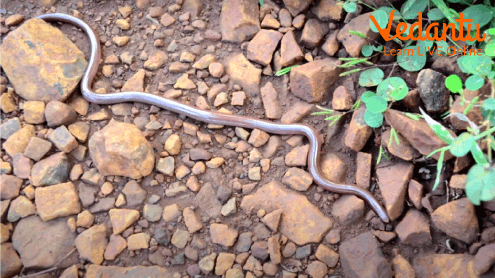




Amphibians Meaning and Examples
Amphibians Definition:Amphibians are vertebrate animals (animals with a backbone). Due to their cold blood, their body temperature is controlled by the environmental temperature. Amphibians are distinguished by their absence of scales, feathers, and hair and their smooth, slimy skin. Many amphibians breathe through their skin rather than their lungs because their skin is porous (air can pass through it).
Examples of amphibians : frogs, toads, salamanders, newts and caecilians.

Amphibians
Types of Amphibians
Here is a kid's list of the most commonly known amphibians:
Frogs
Amphibians of the order Anura include frogs. They often have no tail, webbed fingers and toes, large eyes, and a small torso. Frogs have long, strong legs and are adept jumpers. Frogs of this type of toad exist. The American bullfrog and the poison dart frog are two different species of frogs.

Frog
Salamanders
Salamanders resemble lizards in appearance. They are short-legged, have long tails, and have slender bodies. Salamanders can regrow missing body parts and limbs. They favour marshes and other moist, wet locations.

Salamander
Caecilians
Amphibians, called caecilians, lack both legs and arms. They resemble worms or snakes in appearance. Some of them can grow to lengths of more than 4 feet. They have robust cranium and a pointed nose to help them burrow through soil and mud.

Caecilians
Characteristics of Amphibians
Amphibians live in water and on land.
They are ectothermic creatures that live in warm climates.
Their head and trunk make up their entire body. There might or might not be a tail.
The skin is rough and smooth without scales, but it has glands that keep it moist.
Their fins are not paired. There may be fins that are not paired.
They have two sets of limbs for movement.
They breathe through their skin and lungs. Some adults may have gills on the outside.
They have three-chambered hearts.
Mesonephric kidneys are present. The excretory substance consists of urea and ammonia.
The sexes are distinct, and external fertilization is typical. Salamanders, on the other hand, undergo internal fertilization.
In water, breeding takes place. In males, the copulatory organs are lacking.
Metamorphosis is a form of indirect development in amphibia. It simply means that when a baby hatches from the egg, it has to go through several distinct stages of development, which are different from the adult stage, to finally reach the adult stage.
Kids List of Amphibians
Some of the examples of amphibians for kids are:
Bullfrog
American toad
Wood frog
Spotted salamander
Pacific tree frog
Facts About Amphibians
Frogs cannot survive in saltwater.
Tropical rainforests are home to more than 75% of the world's toad and frog species.
The idea that touching a frog or toad can cause warts is untrue.
Amphibians come in more than 4,000 different varieties.
Nearly all amphibians are capable of generating toxins through their skin. Some of these toxins can be detected by smell.
All amphibians have gills and tails when they first emerge from the water. For life on land, they build lungs and legs as they grow.
Frogs consume their meals whole. Their lips and stomach sizes dictate how much food they can consume.
Solved Questions
1. What do you mean by the word amphibian?
Ans: The word amphibian means any organism that can live both on land and in water.
2. Where do amphibians live?
Ans: Amphibians can survive both on land and water.
3. How many chambers does an amphibian heart have?
Ans: Amphibians have a three-chambered heart.
Learning by Doing
Write true or false for the following.
Amphibians are warm-blooded vertebrates________
Amphibians have a three-chambered heart______
Amphibians can only survive in terrestrial habitat______
Summary
Amphibians' definition is that they are cold-blooded vertebrates with smooth and slimy skin. They make their presence in both aquatic and terrestrial adaptations as such the word amphibian means two lives. Streams, woodlands, meadows, bogs, swamps, ponds, rainforests, and lakes are just a few of the numerous habitats in which amphibians have evolved to survive. The majority of them like to reside in wet, water-related environments. Examples of amphibians for kids are bullfrog, toad, newt etc
Adult amphibians hunt and consume prey. They consume a range of foods, such as worms, spiders, and beetles. To catch their prey, some of them, like frogs, fling out their lengthy tongues with sticky endings.
FAQs on Amphibians
1. What do amphibians consume?
Amphibians consume a range of foods, such as worms, spiders, and beetles.
2. What are the groups of amphibians?
Amphibians are a class that comes under the phylum Vertebrata. They are further subdivided into three different groups-
Anura: Also called Salientia, this group primarily includes toads and frogs, making them one of the most significant orders of the class.
Apoda: As the least familiar of orders, this group of amphibians primarily covers caecilians, which live in the ground and streams.
Urodela: These amphibians include newts and salamanders with tails and a long yet thin body. They also have fewer bones in the skull.
3. How do amphibians respire?
Amphibians have two modes of their respiration because of their adaptation. Thus they can respire through gills and lungs both.









